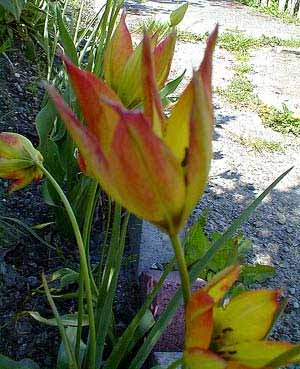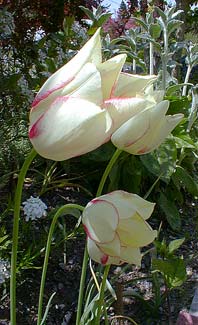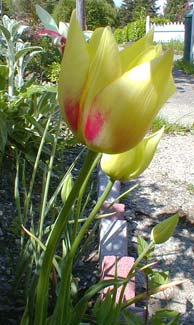
Marjolett's
Botanical
Tulip
With excellent precision
the tulip bed
inside the iron fence
upreared its gaudy
yellow, white and red
The Tulip Bed
by William Carlos Williams
(1883-1963)
by William Carlos Williams
(1883-1963)
Tulipa marjolettii (synonymous with T. perrieri) is a wild tulip native of the Savoy Alps. It was first described in 1894 by Eugene Pierre Perrier de la Bathie & Andrew Songeon.
In the 1970s it was reported to have completely vanished from its natural range, probably from commercial collecting. It is today a protected species in France, though unless there is a project to reestablish it in the Savoys from cultivated stocks, protection comes a mite late.
 It is believed to have once been a cultivated tulip that became extinct in gardens but naturalized in southern France, then was rediscovered in the very late 1800s & reintroduced to gardening. It is, like T. didieri also of Savoy, a "Neo-Tulipae," meaning it is of comparative recent origin of unknown ancestry, whether or not properly a distinct species.
It is believed to have once been a cultivated tulip that became extinct in gardens but naturalized in southern France, then was rediscovered in the very late 1800s & reintroduced to gardening. It is, like T. didieri also of Savoy, a "Neo-Tulipae," meaning it is of comparative recent origin of unknown ancestry, whether or not properly a distinct species.  Though it can grow to two feet tall, usually it is shorter. There were at one time a handful of cultivars that seem not to have been preserved.
Though it can grow to two feet tall, usually it is shorter. There were at one time a handful of cultivars that seem not to have been preserved.Ours have flowered most years in May, though in 2005 they flowered in April. There is variation in their color & behavior from year to year, but for our small group of them, the pointed petals usually open a pure pale creamy yellow, then very quickly develop a bright red blush first on the lower outside.
The second photo from May (2004) shows it in a paler than usual year when there was hardly any yellow when it first opened, & the tulip was primarily white, though it very soon begins to gain color, as shown in the third photo.
The rosy blush daily increases in intensity along the outer midribs, until two or three weeks later it is a very deeply colored red & yellow, as in the first photo. The anthers are always black at the center of a greenish eye.
They are quite pretty & moderately showy, though humble compared to ornate cultivated hybrids. Only a couple decades ago Marjolett tulips were given their own sections in catalogs, but alas their popularity did not last, as they could not compete with showier species let alone with the extreme hybrids. Many of the select clones & hybridized Marjoletts of the past have vanished from cultivation.
If someone is not solely enamored of gaudy tulips, a Marjolett may even today find preference for bringing color without excess into the garden.
They require a hot, brightly sunny location. They naturalize easily, both by self-seeding, & by bulb offsets. They can be lifted in autumn to separate offsets if one wishes to plant some of them elsewhere.